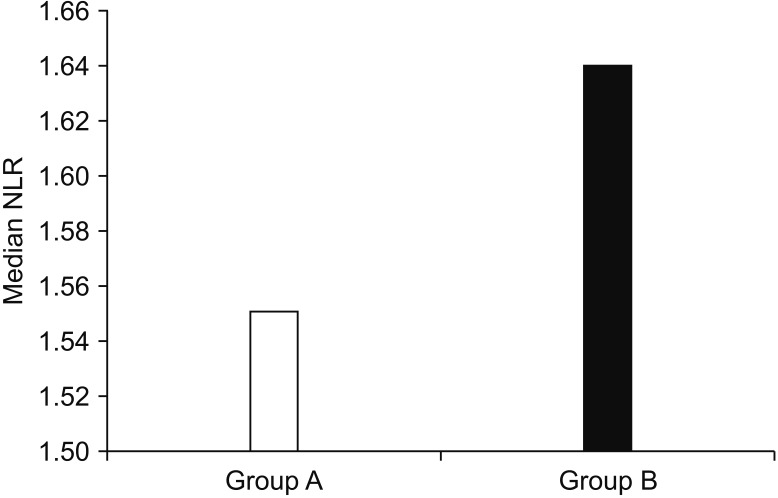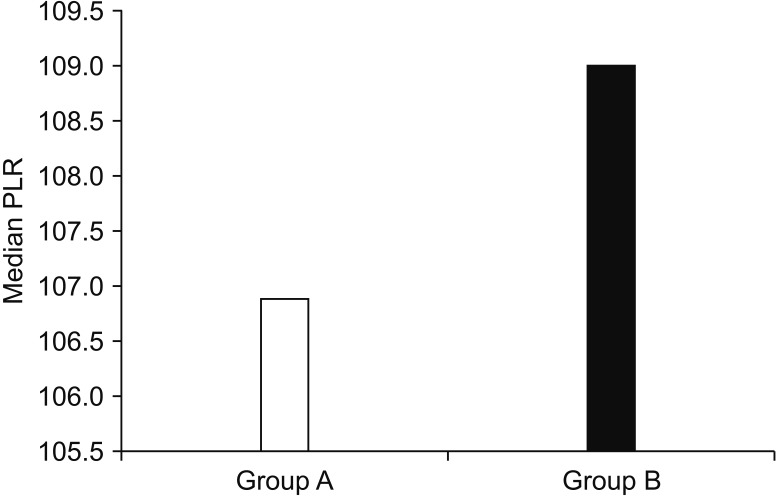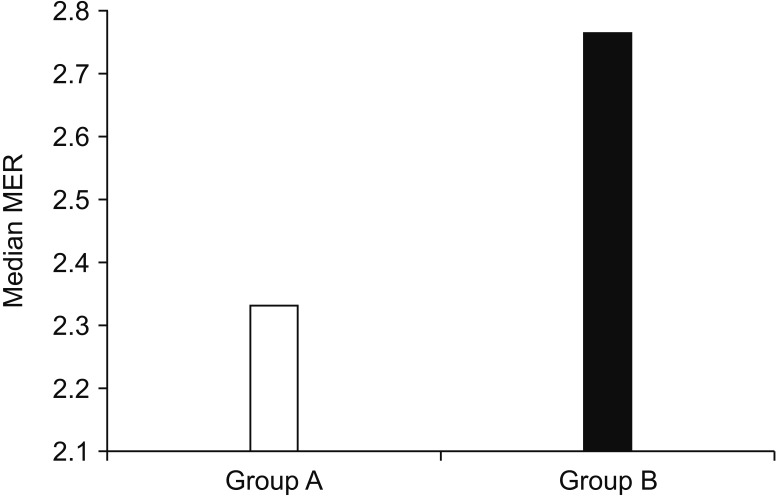World J Mens Health.
2019 Sep;37(3):347-354. 10.5534/wjmh.180110.
Male Inflammatory Parameters Are not Useful to Predict the Outcomes of Intracytoplasmic Sperm Injection: Results from a Cross-Sectional Study
- Affiliations
-
- 1Department of Urology, Careggi Hospital, University of Florence, Florence, Italy. gianmartin.cito@gmail.com
- 2Assisted Reproductive Technology Centre, Careggi Hospital, University of Florence, Florence, Italy.
- 3Department of Urology, Vittorio Emanuele II, University of Catania, Catania, Italy.
- 4Department of Urology, Santa Chiara Regional Hospital, Trento, Italy.
- 5Department of Obstetrics and Gynecology, Santa Chiara Hospital, University of Pisa, Pisa, Italy.
- KMID: 2455411
- DOI: http://doi.org/10.5534/wjmh.180110
Abstract
- PURPOSE
The relationship between male systemic inflammation and fertility seems intriguing, but no data about its impact on the assisted reproductive technology outcomes has been reported. Here, we aimed to evaluate the prognostic role of male systemic inflammatory parameters in intracytoplasmic sperm injection (ICSI) outcomes prediction, in couples undergoing an ovum donation program.
MATERIALS AND METHODS
From January 2016 to December 2017, one hundred-ten couples were considered for this cross-sectional study. Neutrophil-to-lymphocyte ratio (NLR), monocyte-to-eosinophil ratio (MER), platelet-to-lymphocyte ratio (PLR), seminal parameters, fertilization rate (FR), cleavage rate (CR), pregnancy rate (PR) were evaluated. Male patients were divided into Group A with FR ≤70%, Group B with FR >70%.
RESULTS
Overall, FR was 74.5%, CR 90.9%, PR 41.8%. Group A included 43 patients, Group B 67 men. Group A showed a median NLR of 1.55, PLR of 106.09, MER of 2.33. Group B reported a median NLR of 1.64, PLR 109.0, MER 2.76. We found no statistically differences between two groups with respect to NLR, PLR, MER (p=0.90, p=0.70, p=0.96, respectively). The age-adjusted linear regression analysis demonstrated only a relationship between NLR and sperm motility count (r=−0.02; p<0.05). Using the univariate logistic regression analysis, we found no significant associations.
CONCLUSIONS
We did not find any relationship between ICSI outcomes and male inflammation parameters.
Keyword
MeSH Terms
Figure
Reference
-
1. Pasqualotto FF, Pasqualotto EB, Sobreiro BP, Hallak J, Medeiros F, Lucon AM. Clinical diagnosis in men undergoing infertility investigation in a university hospital. Urol Int. 2006; 76:122–125. PMID: 16493211.
Article2. Fraczek M, Kurpisz M. Cytokines in the male reproductive tract and their role in infertility disorders. J Reprod Immunol. 2015; 108:98–104. PMID: 25796532.
Article3. Azenabor A, Ekun AO, Akinloye O. Impact of inflammation on male reproductive tract. J Reprod Infertil. 2015; 16:123–129. PMID: 26913230.4. Hamada A, Esteves SC, Nizza M, Agarwal A. Unexplained male infertility: diagnosis and management. Int Braz J Urol. 2012; 38:576–594. PMID: 23131516.
Article5. Zahorec R. Ratio of neutrophil to lymphocyte counts: rapid and simple parameter of systemic inflammation and stress in critically ill. Bratisl Lek Listy. 2001; 102:5–14. PMID: 11723675.6. Celikbilek M, Dogan S, Ozbakır O, Zararsız G, Kücük H, Gürsoy S, et al. Neutrophil-lymphocyte ratio as a predictor of disease severity in ulcerative colitis. J Clin Lab Anal. 2013; 27:72–76. PMID: 23292894.
Article7. Kurtul BE, Ozer PA. The relationship between neutrophil-to-lymphocyte ratio and age-related macular degeneration. Korean J Ophthalmol. 2016; 30:377–381. PMID: 27729758.
Article8. Duksal F, Alaygut D, Güven AS, Ekici M, Oflaz MB, Tuncer R, et al. Neutrophil-lymphocyte ratio in children with familial Mediterranean fever: original article. Eur J Rheumatol. 2015; 2:20–23. PMID: 27708915.
Article9. Imtiaz F, Shafique K, Mirza SS, Ayoob Z, Vart P, Rao S. Neutrophil lymphocyte ratio as a measure of systemic inflammation in prevalent chronic diseases in Asian population. Int Arch Med. 2012; 5:2. PMID: 22281066.
Article10. Aykan S, Canat L, Gönültaş S, Atalay HA, Altunrende F. Are there relationships between seminal parameters and the neutrophil-to-lymphocyte ratio or the platelet-to-lymphocyte ratio? World J Mens Health. 2017; 35:51–56. PMID: 28459146.
Article11. Lampiao F, du Plessis SS. TNF-alpha and IL-6 affect human sperm function by elevating nitric oxide production. Reprod Biomed Online. 2008; 17:628–631. PMID: 18983746.12. Zhang H, Yin Y, Wang G, Liu Z, Liu L, Sun F. Interleukin-6 disrupts blood-testis barrier through inhibiting protein degradation or activating phosphorylated ERK in Sertoli cells. Sci Rep. 2014; 4:4260. PMID: 24584780.
Article13. Zalata A, Atwa A, El-Naser Badawy A, Aziz A, El-Baz R, Elhanbly S, et al. Tumor necrosis factor-α gene polymorphism relationship to seminal variables in infertile men. Urology. 2013; 81:962–966. PMID: 23465534.
Article14. Timur H, Kokanali MK, Inal HA, Tuzluoglu D, Yilmaz N. A study on the association between serum amyloid A and sperm concentration. Andrologia. 2016; 48:626–630. PMID: 26437740.
Article15. Yoon NB, Son C, Um SJ. Role of the neutrophil-lymphocyte count ratio in the differential diagnosis between pulmonary tuberculosis and bacterial community-acquired pneumonia. Ann Lab Med. 2013; 33:105–110. PMID: 23482854.
Article16. Wang GY, Yang Y, Li H, Zhang J, Jiang N, Li MR, et al. A scoring model based on neutrophil to lymphocyte ratio predicts recurrence of HBV-associated hepatocellular carcinoma after liver transplantation. PLoS One. 2011; 6:e25295. PMID: 21966488.
Article17. Kaya H, Ertaş F, İslamoğlu Y, Kaya Z, Atılgan ZA, Çil H, et al. Association between neutrophil to lymphocyte ratio and severity of coronary artery disease. Clin Appl Thromb Hemost. 2014; 20:50–54. PMID: 22790659.
Article18. Sunbul M, Gerin F, Durmus E, Kivrak T, Sari I, Tigen K, et al. Neutrophil to lymphocyte and platelet to lymphocyte ratio in patients with dipper versus non-dipper hypertension. Clin Exp Hypertens. 2014; 36:217–221. PMID: 23786430.
Article19. Liu CL, Lee JJ, Liu TP, Chang YC, Hsu YC, Cheng SP. Blood neutrophil-to-lymphocyte ratio correlates with tumor size in patients with differentiated thyroid cancer. J Surg Oncol. 2013; 107:493–497. PMID: 22996403.
Article20. Celik T. Assessment of neutrophil-to-lymphocyte ratio and platelet-to-lymphocyte ratio in patients with dry eye disease. Ocul Immunol Inflamm. 2018; 26:1219–1222. PMID: 28910561.
Article21. Yucel C, Keskin MZ, Cakmak O, Ergani B, Kose C, Celik O, et al. Predictive value of pre-operative inflammation-based prognostic scores (neutrophil-to-lymphocyte ratio, platelet-to-lymphocyte ratio, and monocyte-to-eosinophil ratio) in testicular sperm extraction: a pilot study. Andrology. 2017; 5:1100–1104. PMID: 28992369.
Article22. Hermosilla C, Caro TM, Silva LM, Ruiz A, Taubert A. The intriguing host innate immune response: novel anti-parasitic defence by neutrophil extracellular traps. Parasitology. 2014; 141:1489–1498. PMID: 24721985.
Article23. Hales DB. Testicular macrophage modulation of Leydig cell steroidogenesis. J Reprod Immunol. 2002; 57:3–18. PMID: 12385830.
Article24. Duran EH, Dowling-Lacey D, Bocca S, Stadtmauer L, Oehninger S. Impact of male age on the outcome of assisted reproductive technology cycles using donor oocytes. Reprod Biomed Online. 2010; 20:848–856. PMID: 20378414.
Article25. Luna M, Finkler E, Barritt J, Bar-Chama N, Sandler B, Copperman AB, et al. Paternal age and assisted reproductive technology outcome in ovum recipients. Fertil Steril. 2009; 92:1772–1775. PMID: 19539905.
Article26. Aitken RJ, De Iuliis GN. Origins and consequences of DNA damage in male germ cells. Reprod Biomed Online. 2007; 14:727–733. PMID: 17579989.
Article27. Yldrm G, Tokmak A, Kokanal MK, Sarkaya E, Züngün C, İnal HA, et al. Association between some inflammatory markers and primary ovarian insufficiency. Menopause. 2015; 22:1000–1005. PMID: 25647778.
Article28. ESHRE Special Interest Group of Embryology and Alpha Scientists in Reproductive Medicine. The Vienna consensus: report of an expert meeting on the development of ART laboratory performance indicators. Reprod Biomed Online. 2017; 35:494–510. PMID: 28784335.29. Alpha Scientists In Reproductive Medicine. The Alpha consensus meeting on cryopreservation key performance indicators and benchmarks: proceedings of an expert meeting. Reprod Biomed Online. 2012; 25:146–167. PMID: 22727888.
- Full Text Links
- Actions
-
Cited
- CITED
-
- Close
- Share
- Similar articles
-
- Physiological intracytoplasmic sperm injection does not improve the quality of embryos: A cross-sectional investigation on sibling oocytes
- A Case of Globozoospermia Conceived by Intracytoplasmic Sperm Injection
- Semen parameters on the intracytoplasmic sperm injection day: Predictive values and cutoff thresholds of success
- Twin Pregnancy and Delivery After Intracytoplasmic Sperm Injection Followed by Calcium Ionophore with Spermatozoa from a Globozoospermic Man: A Case Report
- Clinical Study on Intracytoplasmic Sperm Injection Using Epididymal and Testicular Sperm




